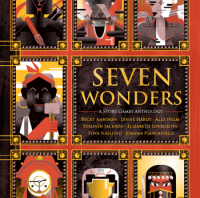Rise and Fall
 Designed by Elizabeth Lovegrove and Published by Pelgrane Press as part of the 7 Wonders Anthology Available at the Pelgrane Press site.
Designed by Elizabeth Lovegrove and Published by Pelgrane Press as part of the 7 Wonders Anthology Available at the Pelgrane Press site.
Pelgrane Press has recently published a fantastic anthology of story games, titled “Seven Wonders”. I will be preparing short reviews of all seven games within the book as part of my “Indie Gems” series. The second of these is a game by Elizabeth Lovegrove, titled “Rise and Fall”.
The introduction begins as follows.
Dystopias come from somewhere, and they go somewhere. They appear because someone is able to convince others that they are reasonable, and they disappear because someone is able to exploit their weaknesses. They rise, and they fall.
This is a game that taps into the zeitgeist by exploring dystopias and fallen societies. It’s clear that the author did their research, and have built on the excellent work of past designers including Ben Robbins (Microscope, Kingdom), and Caroline Hobbs (Downfall). The game uses rather elegant tools of world-building to present a clear story with minimal systems.
The core loop is a straightforward question-exploration-interpretation cycle, which proved its utility in Microscope scene setting. As players, you cycle through a series of scenes that explore the dystopia. One person poses a question and picks out two characters to play through a scene that seeks the answer. When the scene is done, you write the answer down on the central ideas sheet. You continue to add more details to this sheet during play, which creates a compelling artifact.
You repeat the same process for each scene, with the role of questioner rotating around the table. The first third of the scenes explore the rise of the dystopia, the middle third explores its operation, and the last third demonstrates the collapse. This game stands apart from many others, though, by explicitly encouraging generational play. Each player doesn’t have a single fixed character, but rather they embody a persistant archetype such as “Artist”, “Matriarch” or “Warrior”. During play, you create new individuals who fit in both the archetype and the society at that time, discarding characters freely.
I am fond of this game, but I feel that it is a tad understated and restrained. The framework of the game would be robust enough to handle much broader and more complex stories than the base scenario. When I get the opportunity to run this game, I plan on hacking it into a 3-session experience, so that we can dedicate more time to explore each of the three phases of a society. I feel that this game has too much potential to be limited to a single session.



 pent Youth (2010)
pent Youth (2010)